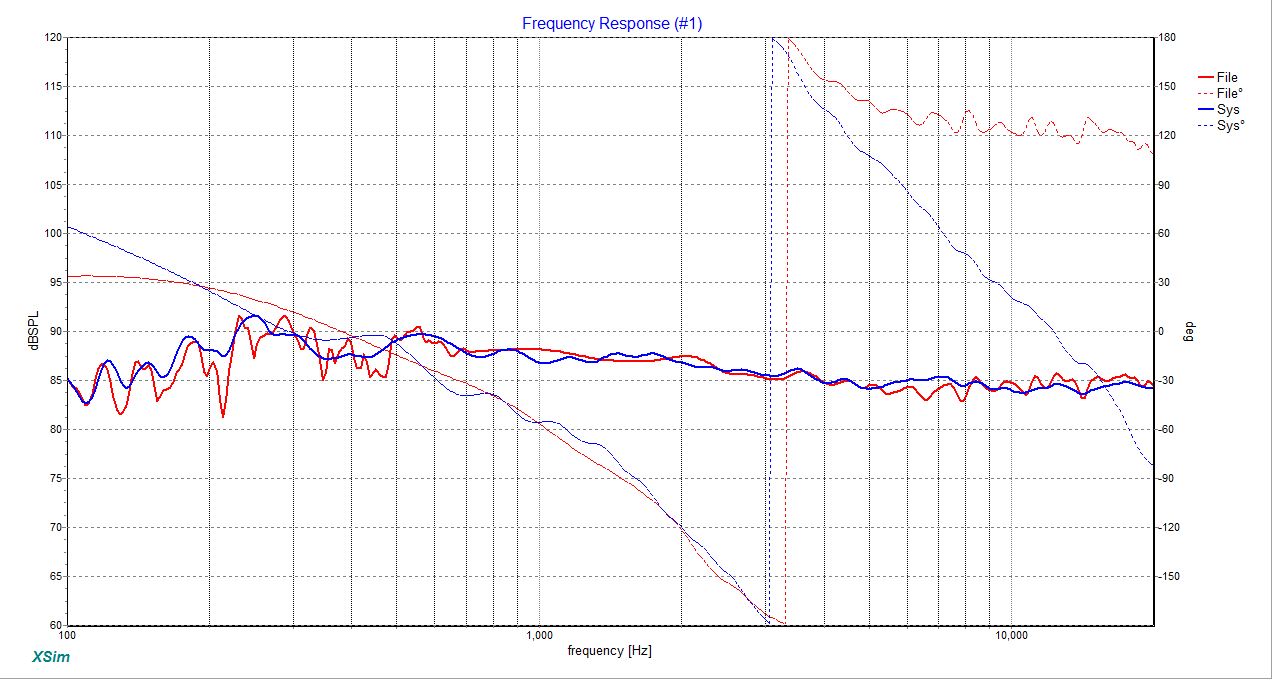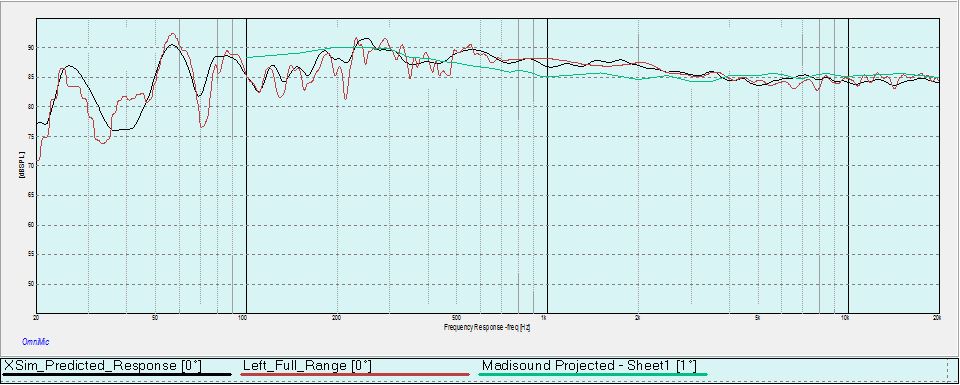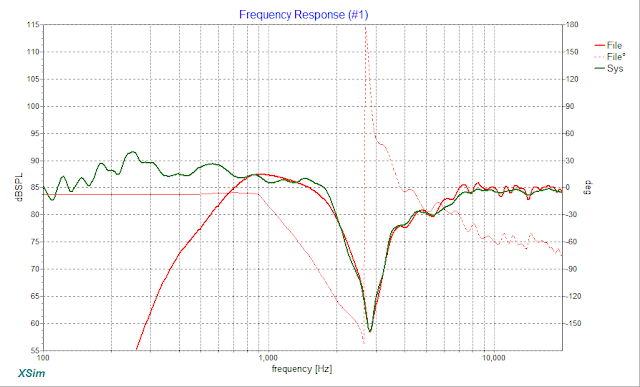Big thanks to Bill Waslo here. Omnimic + DATS + XSim allowed me to hack together a speaker crossover in a couple of hobbyist weeks what would have taken me months of trial, error and experimentation. In fact I may never have gotten results this good without going back to school.
The speaker is a 2 way with ScanSpeak 7" revelator and Mundorf AMT. Crossover design is a little more complicated than basic 2nd order LR. Total 6 parts in the tweeter, 6 in the woofer.
After purchasing the parts I went back and measured with DATS the actual cap and inductor values, adding ESR and DCR respectively.
To make an otherwise long story short, please see the comparison betwen the simulated crossover in blue, and the actual finished speaker in red. Besides measuring with DATS, the big secret for me was to measure the drivers and impedance with the drivers in place.
Outfreaking standing!! I should also point out that XSim beat the Leap woofer crossover simulation done by Madisoun significantly between 100 and 1KHz. Originally I purchased a crossover design from them, but the tweeter ended up being impossible to get, so had to redesign that from scratch pretty much. I think that the guys at Madisound deliberately sweeten the target curves knowing Leap will be somewhat flatter than projected. There's nothing wrong with the sound of their bass though. Outstanding!

The speaker is a 2 way with ScanSpeak 7" revelator and Mundorf AMT. Crossover design is a little more complicated than basic 2nd order LR. Total 6 parts in the tweeter, 6 in the woofer.
After purchasing the parts I went back and measured with DATS the actual cap and inductor values, adding ESR and DCR respectively.
To make an otherwise long story short, please see the comparison betwen the simulated crossover in blue, and the actual finished speaker in red. Besides measuring with DATS, the big secret for me was to measure the drivers and impedance with the drivers in place.
Outfreaking standing!! I should also point out that XSim beat the Leap woofer crossover simulation done by Madisoun significantly between 100 and 1KHz. Originally I purchased a crossover design from them, but the tweeter ended up being impossible to get, so had to redesign that from scratch pretty much. I think that the guys at Madisound deliberately sweeten the target curves knowing Leap will be somewhat flatter than projected. There's nothing wrong with the sound of their bass though. Outstanding!

Last edited:
I wanted to add this chart. It adds the simulated response from LEAP. To be fair, the LEAP design uses a different tweeter, but from what I can tell, the difference you see in the midrange has to do with the projected response curves of the woofer. As you can see, I got the tweeter response pretty close though.


Last edited:
Oops, turns out my driver distance was off. However, it doesn't affect the frequency response. However, check out what happens when I fix the phase angle and then test with the tweeter inverted. In the graph below the red line is measured, the green line is XSim. I had bass off in the test signal, so ignore the roll of on the left. Outstanding accuracy again!  So much so that it let me improve the null from the Leap design by about 15 db.
So much so that it let me improve the null from the Leap design by about 15 db.


Last edited:
Well ah, shucks.... Thanks Erik!
But it would be weird if it didn't work out, since it's math, a bunch of simultaneous equations solved by matrix operations (took a lot of work but all the tricks are old stuff that can be dug up in books or on the net). My only original creation is the user interface and way stuff is kept in files to make it be faster.
Someday i may get back to it so it can simulate off-axis and directivity plots too as originally planned. I had hoped to make a commercial product to be supported by vendors who would also provide data for their products so users could design-by-catalogue, but there wasn't enough user enthusiasm for me to make the case that it would be worth vendors' investment. I think this kind of thing is still way over the heads of most hobbyists, unfortunately, no matter how much the interface is simplified.
But it would be weird if it didn't work out, since it's math, a bunch of simultaneous equations solved by matrix operations (took a lot of work but all the tricks are old stuff that can be dug up in books or on the net). My only original creation is the user interface and way stuff is kept in files to make it be faster.
Someday i may get back to it so it can simulate off-axis and directivity plots too as originally planned. I had hoped to make a commercial product to be supported by vendors who would also provide data for their products so users could design-by-catalogue, but there wasn't enough user enthusiasm for me to make the case that it would be worth vendors' investment. I think this kind of thing is still way over the heads of most hobbyists, unfortunately, no matter how much the interface is simplified.
Well ah, shucks.... Thanks Erik!
But it would be weird if it didn't work out, since it's math, a bunch of simultaneous equations solved by matrix operations (took a lot of work but all the tricks are old stuff that can be dug up in books or on the net). My only original creation is the user interface and way stuff is kept in files to make it be faster.
Someday i may get back to it so it can simulate off-axis and directivity plots too as originally planned. I had hoped to make a commercial product to be supported by vendors who would also provide data for their products so users could design-by-catalogue, but there wasn't enough user enthusiasm for me to make the case that it would be worth vendors' investment. I think this kind of thing is still way over the heads of most hobbyists, unfortunately, no matter how much the interface is simplified.
Bill, I get the math is only non-trivial, but you made it ridiculously easy to use! Every other tool I've tried to learn (and I have not tried all of them) it really would have taken me a year to figure out how to use it.
As it was, with OminMic and DATS, and XSim I could with just a little thought put together a working process that let me go from a cabinet + drivers to a fully functioning loudspeaker in a matter of hours. That is no small feat. The magic is really what you don't include, what isn't necessary to do for the home builder (and in my case I use that phrase loosely). Not trying to simulate the box + drivers + crossovers is great. This way I only need to deal with what's in front of me. Put the drivers in the cabinet, measure frequency and impedancees, simulate the crossover, purchase outrageously priced parts, and solder them onto the back of a Cracker Jack box. Done!
Thanks!
Erik
Last edited:
- Status
- This old topic is closed. If you want to reopen this topic, contact a moderator using the "Report Post" button.
- Home
- Loudspeakers
- Multi-Way
- XSin, er, XSim: Outstanding match to reality
